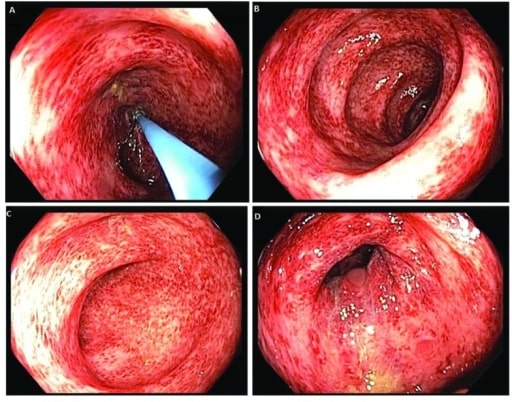Playlist
Show Playlist
Hide Playlist
GI Bleed: Initial Management and Diagnostic Studies
-
Slides Gastroenterology 01 GI Bleed.pdf
-
Download Lecture Overview
00:00 So now, let's talk about the management of a GI bleed. 00:04 The first most important step is to establish adequate IV access. 00:12 By this, we mean placing at least two large-bore peripheral IVs which are 18 gauge or larger or placing a centrally placed large-bore catheter. 00:21 The goal is to be able to rapidly infuse blood products and fluids. 00:27 So to understand why this is important, we'll have to go back to your physics knowledge. 00:32 So we recall from Poiseuille's law in physics that flow or Q in this equation is affected exponentially by the radius and inversely by the length. 00:44 So, why we care about a large-bore IV is because we want a short length and a wide radius in our catheter to make sure that we can maximize the flow through the catheter. 01:00 The next step in management is fluid resuscitation. 01:04 We want to give crystalloid fluids such as normal saline or lactated ringer's solution. 01:11 Next, you should consider transfusing the patient with blood products. 01:15 So, we'll break it down by each type of blood product. 01:19 First, you should consider packed red blood cells or PRBCs. 01:23 In the general, we use a transfusion threshold of a hemoglobin less than 7 for most patients. 01:29 However, you might consider a higher transfusion threshold of less than 8 for patients who have coronary artery disease or have active bleeding. 01:40 The next blood product you should consider is platelets. 01:44 In general, we transfuse platelets for patients who are actively bleeding when their baseline platelets are less than 50,000. 01:52 There are other blood products you can consider such as fresh frozen plasma or FFP to correct underlying coagulopathies. 02:00 However, that is beyond the scope of this lecture. 02:04 The next step in management is to give medications to stabilize the bleeding. 02:09 So, all patient should receive a proton pump inhibitor. 02:12 This is to reduce acid secretion in the stomach and hopefully slow the rate of bleeding if they have an upper GI bleed. 02:20 Next, you can consider giving vasoactive medications such as octreotide but this is only if you suspect a variceal bleed. 02:30 The last thing you can consider is any reversal agents for anticoagulants that your patient takes, if they are available. 02:38 The last step in management after you have fluid resuscitated and stabilized the patient is to consult the GI specialist. 02:46 This is so that they can perform both diagnostic and therapeutic interventions to control the bleeding. 02:54 So now let's move on to talk about the various diagnostic and therapeutic studies we have available. 03:00 So the gold standard for diagnosing and controlling a GI bleed is upper or lower endoscopy. 03:08 There are other options we have available including push enteroscopy. 03:13 This is a more complicated type of endoscopy by which we are able to visualize the small bowel which is otherwise unable to be reached by either upper or lower endoscopy. 03:25 The next test you may consider are nuclear scintigraphy which is a tagged red blood cell scan or CT angiography. 03:33 By either of these modalities, you can detect slower rates of GI bleeding. 03:37 However, keep in mind that both of these tests are imaging test only and so you may find the location of the bleeding but you will not be able to intervene. 03:49 The last test we have available is standard angiography. 03:52 This is usually performed by interventional radiologist who can thread the catheter through the groin up into the vessels that may be contributing to the bleeding. 04:02 This is also a therapeutic intervention if they are able to find and embolize the vessel that is causing the bleeding. 04:11 So now that we've gone through all of that, let's return to our case. 04:15 We have Mr. Gibb who is a 56-year-old man who's coming in with some concerning GI symptoms. 04:21 He does have a history of NSAID and alcohol use and he has signs on exam of hypovolemia, anemia and some localizing symptoms of epigastric pain. 04:32 He is also shown to be anemic. 04:34 So, now we know that his symptoms of coffee ground emesis and dull epigastric pain are concerning for an upper GI bleed. 04:43 In addition, his risk factors of heavy NSAID and alcohol use place him at risk for a differential of peptic ulcer disease, potentially gastritis or cancer. 04:55 So we are asked what is the best next step in management? Now we know that the first step is always to establish adequate peripheral IV access and note that he already has supine hypotension so he should be given aggressive fluid resuscitation. 05:13 At this time, he currently does not meet the threshold for our packed red blood cell transfusion with a hemoglobin of 11 but he is presenting with general bleeding so a proton pump inhibitor should be started. 05:27 Thank you very much for your attention.
About the Lecture
The lecture GI Bleed: Initial Management and Diagnostic Studies by Kelley Chuang, MD is from the course Approach to Patients with GI Symptoms.
Included Quiz Questions
Which of the following is the best initial step in the management of active GI bleeding?
- Adequate IV access and fluid resuscitation
- GI consult
- Proton pump inhibitors
- Octreotide
- Platelet transfusion
Which of the following is the diagnostic test of choice for an upper GI bleed?
- Endoscopy
- Colonoscopy
- CT angiography
- Nuclear scintigraphy
- Standard angiography
Which of the following levels of hemoglobin is the indication for blood transfusion in a patient with active GI bleeding?
- <8 g/dL
- <9 g/dL
- <10 g/dL
- <11 g/dL
- <12 g/dL
Customer reviews
5,0 of 5 stars
| 5 Stars |
|
1 |
| 4 Stars |
|
0 |
| 3 Stars |
|
0 |
| 2 Stars |
|
0 |
| 1 Star |
|
0 |
I love the details for the management of the patient and the lecture follows Step Up To Medicine well.




